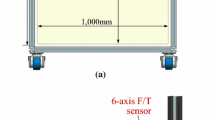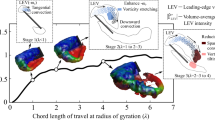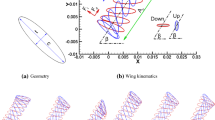Abstract
This study explores the wake effects of an upstream leading insect on the flight performance of a following one. The potential-flow based aerodynamic model, which combines the unsteady panel and unsteady vortex-lattice methods, is used to compute aerodynamic loads and simulate wake structures. The accuracy of the current aerodynamic model was confirmed in this study. The paper shows that the following insect does not cause any noticeable impact on the leading insect aerodynamics, while unfavorable effects due to the presence of the leading insect were found on the following counterpart. Nonetheless, by choosing a proper wing kinematic phase, the following insect may absorb the energy of the leading insect’s trailing wake, and therefore mitigate these negative effects. The variations of the required mechanical power of the following insect against the wing kinematic phase difference were shown to be related to the travel of the leading insect’s downstroke starting vortex.
Similar content being viewed by others
References
W. Shyy, H. Aono, S. K. Chimakurthi, P. Trizila, C. K. Kang, C. E. Cesnik and H. Liu, Recent progress in flapping wing aerodynamics and aeroelasticity, Progress in Aerospace Sciences, 46 (7) (2010) 284–327.
J. K. Kim, J. S. Han, J. S. Lee and J. H. Han, Hovering and forward flight of the hawkmoth Manduca sexta: Trim search and 6-DOF dynamic stability characterization, Bioinspiration & Biomimetics, 10 (5) (2015) 56012.
H. Liu, S. Ravi, D. Kolomenskiy and H. Tanaka, Biomechanics and biomimetics in insect-inspired flight systems, Philosophical Transactions of the Royal Society B, 371 (1704) (2016) 20150390.
A. T. Nguyen, J.-S. Han and J.-H. Han, Effect of body aerodynamics on the dynamic flight stability of the hawkmoth Manduca sexta, Bioinspiration & Biomimetics, 12 (1) (2016) 16007.
C. P. Ellington, C. Van den Berg, A. P. Willmott and A. L. R. Thomas, Leading-edge vortices in insect flight, Nature, 384 (6610) (1996) 626–630.
M. H. Dickinson, F. O. Lehmann and S. P. Sane, Wing rotation and the aerodynamics basis of insect flight, Science, 284 (5422) (1999) 1954–1960.
S. P. Sane and M. H. Dickinson, The aerodynamic effects of wing rotation and a revised quasi-steady model of flapping flight, J. of Experimental Biology, 205 (8) (2002) 1087–1096, http://jeb.biologists.org/content/205/8/1087.
J. S. Han, J. W. Chang, J. K. Kim and J. H. Han, Role of trailing-edge vortices on the hawkmothlike flapping wing, J. of Aircraft, 52 (4) (2015) 1256–1266.
V. M. Ortega-Jimenez, J. S. M. Greeter, R. Mittal and T. L. Hedrick, Hawkmoth flight stability in turbulent vortex streets, J. of Experimental Biology, 216) (2013) 4567–4579.
S. Ravi, J. D. Crall, A. Fisher and S. A. Combes, Rolling with the flow: bumblebees flying in unsteady wakes, J. of Experimental Biology, 216) (2013) 4299–4309.
J. T. Vance, I. Faruque and J. S. Humbert, Kinematic strategies for mitigating gust perturbations in insects, Bioinspiration & Biomimetics, 8 (1) (2013) 16004.
K. Warfvinge, M. Kleinheerenbrink and A. Hedenstro, The power-speed relationship is U-shaped in two free-flying hawkmoths (Manduca sexta), J. of The Royal Society Interface, 14 (134) (2017) 20170372.
A. P. Willmott and C. P. Ellington, The mechanics of flight in the hawkmoth Manduca sexta: I. Kinematics of hovering and forward flight, J. of Experimental Biology, 200 (21) (1997) 2705–2722.
H. Liu and H. Aono, Size effects on insect hovering aerodynamics: an integrated computational study, Bioinspiration & Biomimetics, 4 (1) (2009) 15002.
J. M. Birch, The influence of wing-wake interactions on the production of aerodynamic forces in flapping flight, J. of Experimental Biology, 206 (13) (2003) 2257–2272.
Y. Ryu, J. W. Chang, J. Chung and D. Kim, Experimental investigation of flexible hawkmoth-like wings on the wing-wake interaction in hovering flight, J. of Bionic Engineering, 15 (1) (2018) 139–153.
K. Senda, T. Obara, M. Kitamura, N. Yokoyama, N. Hirai and M. Iima, Effects of structural flexibility of wings in flapping flight of butterfly, Bioinspiration & Biomimetics, 7 (2) (2012) 25002.
J. E. Bluman, M. K. Sridhar and C. Kang, The influence of wing flexibility on the stability of a biomimetic flapping wing micro air vehicle in hover, 57th AIAA/ASCE/AHS/ASC Structures, Structural Dynamics, and Materials Conference, San Diego, California, USA (2016) 0470.
S. Kauertz, F. Holzäpfel and J. Kladetzke, Wake vortex encounter risk assessment for crosswind departures, J. of Aircraft, 49 (1) (2012) 281–291.
D. Bieniek, R. Luckner, I. De Visscher and G. Winckelmans, Simulation methods for aircraft encounters with deformed wake vortices, J. of Aircraft, 53 (1) (2016) 1581–1596.
C. P. Ellington, The aerodynamics of hovering insect flight: II. Morphological parameters, Philosophical Transactions of the Royal Society B, 305) (1984) 17–40.
R. P. O’Hara and A. N. Palazotto, The morphological characterization of the forewing of the Manduca sexta species for the application of biomimetic flapping wing micro air vehicles, Bioinspiration & Biomimetics, 7 (4) (2012) 46011.
A. P. Willmott, The Mechanics of Hawkmoth Flight, Ph.D. Dissertation, Dept. of Zoology, Univ. of Cambridge, UK (1995).
J. Katz and A. Plotkin, Low-speed Aerodynamics from Wing Theory to Panel Methods, 2nd Ed., Cambridge University Press, New York, USA (2001).
B. A. Roccia, S. Preidikman, J. C. Massa and D. T. Mook, Modified unsteady vortex-lattice method to study flapping wings in hover flight, AIAA J., 51 (11) (2013) 2628–2642.
A. T. Nguyen, J.-K. Kim, J.-S. Han and J.-H. Han, Extended unsteady vortex-lattice method for insect flapping wings, J. of Aircraft, 53 (6) (2016) 1709–1718.
J.-H. Han and A. T. Nguyen, Dynamic stability of flapping-wing micro air vehicles with unsteady aerodynamic model, ASME 2017 Fluids Engineering Division Summer Meeting, Waikoloa, Hawaii, USA (2017) V01AT01A002.
A. T. Nguyen and J.-H. Han, Modified unsteady vortex lattice method for aerodynamics of flapping wing models, ASME/JSME/KSME 2015 Joint Fluids Engineering Conference, Seoul, South Korea (2015) V01AT04A001.
H. Liu, C. Ellington, K. Kawachi, C. Van Den Berg and A. P. Willmott, A computational fluid dynamic study of hawkmoth hovering, J. of Experimental Biology, 201 (4) (1998) 461–477.
E. C. Polhamus, Predictions of vortex-lift characteristics by a leading-edge suction analogy, J. of Aircraft, 8 (4) (1971) 193–199.
M. Ramasamy and J. G. Leishman, A Reynolds number-based blade tip vortex model, J. of the American Helicopter Society, 52 (3) (2007) 214–223.
F. Gandhi and L. Tauszig, A critical evaluation of various approaches for the numerical detection of helicopter blade-vortex interactions, J. of the American Helicopter Society, 45 (3) (2000) 179–190.
J. K. Kim and J. H. Han, Control effectiveness analysis of the hawkmoth Manduca sexta: A multibody dynamics approach, International J. of Aeronautical and Space Sciences, 14 (2) (2013) 152–161.
A. T. Nguyen and J. H. Han, Wing flexibility effects on the flight performance of an insect-like flapping-wing micro-air vehicle, Aerospace Science and Technology, 79) (2018) 468–481.
H. Aono, W. Shyy and H. Liu, Near wake vortex dynamics of a hovering hawkmoth, Acta Mechanica Sinica, 25) (2009) 23–36.
K. B. Lua, K. C. Lai, T. T. Lim and K. S. Yeo, On the aerodynamic characteristics of hovering rigid and flexible hawkmoth-like wings, Experiments in Fluids, 49 (6) (2010) 1263–1291.
J. K. Wang and M. A. Sun, Computational study of the aerodynamics and forewing - hindwing interaction of a model dragonfly in forward flight, J. of Experimental Biology, 208 (19) (2005) 3785–3804.
M. Sun and S. L. Lan, A computational study of the aerodynamic forces and power requirements of dragonfly (Aeschna juncea) hovering, J. of Experimental Biology, 207 (11) (2004) 1887–1901.
T. M. Casey, A comparison of mechanical and energetic estimates of flight cost for hovering sphinx moths, J. of Experimental Biology, 91 (1) (1981) 117–129.
M. Sun and J. Tang, Lift and power requirements of hovering flight in Drosophila virilis, J. of Experimental Biology, 205 (16) (2002) 2413–2427.
W. J. Maybury and F. Lehmann, The fluid dynamics of flight control by kinematic phase lag variation between two robotic insect wings, J. of Experimental Biology, 207 (26) (2004) 4707–4726.
A. P. Willmott and C. P. Ellington, The mechanics of flight in the hawkmoth Manduca sexta: II. Aerodynamic consequences of kinematic and morphological variation, J. of Experimental Biology, 200 (21) (1997) 2723–2745.
D. J. Lee and C. A. Smith, Effect of vortex core distortion on blade-vortex interaction, AIAA J., 29 (9) (1991) 1355–1362.
Acknowledgments
This research is funded by Vietnam National Foundation for Science and Technology Development (NAFOSTED) under grant number 107.01-2018.05.
Author information
Authors and Affiliations
Corresponding author
Additional information
Recommended by Associate Editor Seongwon Kang
Anh Tuan Nguyen is a lecturer at the Faculty of Aerospace Engineering, Le Quy Don Technical University, Ha Noi, Vietnam. He received his Ph.D. in aerospace engineering from KAIST, Daejeon, S. Korea, in 2017. His research interests are bioinspired flapping-wing micro air vehicles, unsteady aerodynamics, multibody dynamics and aeroelasticity.
Thanh Dong Pham is a lecturer at the Faculty of Aerospace Engineering, Le Quy Don Technical University, Ha Noi, Vietnam. He received the Master of Science in Russia in 2012. His research interests are aerodynamics of rotor machines, unsteady aerodynamics and multibody dynamics.
Quoc Tru Vu is an Associate Professor at the Faculty of Aerospace Engineering, Le Quy Don Technical University, Ha Noi, Vietnam. He received the Ph.D. from Le Quy Don Technical University in 2002. His research interests are aircraft system design, aircraft structure, unsteady aerodynamics and aeroelasticity.
Rights and permissions
About this article
Cite this article
Nguyen, A.T., Pham, T.D. & Vu, Q.T. Flapping flight in the wake of a leading insect. J Mech Sci Technol 33, 3277–3288 (2019). https://doi.org/10.1007/s12206-019-0623-4
Received:
Revised:
Accepted:
Published:
Issue Date:
DOI: https://doi.org/10.1007/s12206-019-0623-4




